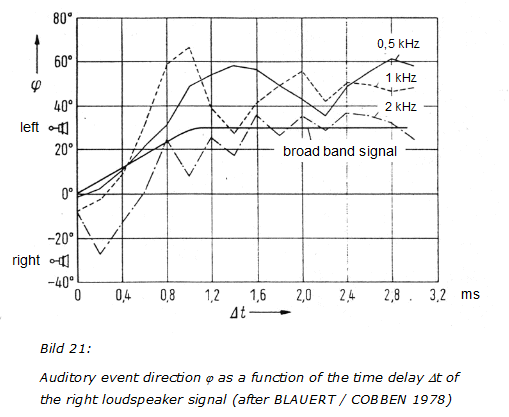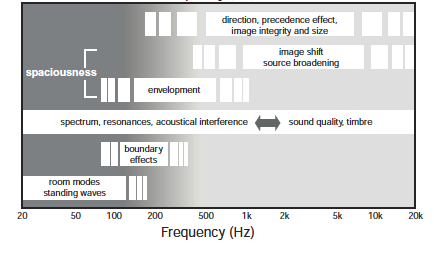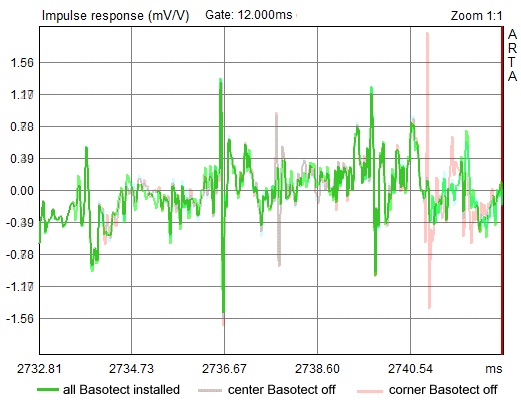Naughty boy
You still haven't looked into http://www.hauptmikrofon.de/theile/ON_THE_LOCALISATION_english.pdf ?
Markus had asked you ages ago to take a look. Now please at least read pages 51-53. I just show you this diagram from 1978 for starters:
View attachment 333688
Do you see how ITD perception can do without those low frequencies?
Rudolf
What is being refered here is not ITD, but Interaural Envelope Time Difference (IETD):The temporal difference of the modulation pattern between the two ears. It's totally different from ITD as described in Rayleigh dublex theory of hearing.
- Elias
The problem isn't really about localization priority of 200Hz vs. 2kHz under free field conditions, it's about what the room-speaker interaction does to the stereo signal around and above the Schröder frequency. The rather large level differences of the steady state response between L and R distort localization cues of the stereo signal.
Hence the real question is probably "can speaker directivity help decreasing localization cue distortion"?
Yes exactly this is very much the correct point.
High directivity below 1kHz does help in presenting the correct localisation cues to the listening position.
While we can still debate the priority of cues in different freq bands, and what freqs give more correct perceptional directions.
This from Blauert:
UNIVERSITY OF MIAMI
Horizontal plane localization of sinusoidal (solid) and narrow band noise (dotted) as compared to a reference sound of wide-band noise at 0, 40, and 320 degree azimuth locations. Shown versus frequencies to 5 kHz. Reprinted from Blauert (1999) with permission from the MIT press
An externally hosted image should be here but it was not working when we last tested it.
You can see localisation accuracy improves towards lower frequencies. There is no evident trend to be seen that localisation accuracy would get worse towards 500Hz but all the curves merge together and not deviate. Actually the highest deviation is to be seen above 2kHz.
- Elias
Elias,What is being refered here is not ITD, but Interaural Envelope Time Difference (IETD):The temporal difference of the modulation pattern between the two ears. It's totally different from ITD as described in Rayleigh dublex theory of hearing.
I've asked the Lord and he told me, that the broadband signal is judged by it's IETD indeed. But I don't see yet how this changes my point, that the localization of broadband signals is not derived from their low frequency part (500 Hz and below), but from cues at higher frequencies.
Rudolf
Elias,
I've asked the Lord and he told me, that the broadband signal is judged by it's IETD indeed. But I don't see yet how this changes my point, that the localization of broadband signals is not derived from their low frequency part (500 Hz and below), but from cues at higher frequencies.
Rudolf
I'm delighted to hear the Good Lord has helped you
Maybe you'll like to take another look at the figure in my post #1402.
The localisation angles for wide band signal are shown with arrows. The localisation angle for narrow band signal is the dotted line. You'll see at low freqs the angles for wide and narrow band signals coincide, whereas at high freqs the angle for narrow band signal deviates from wide band angle. This is to say localisation angle be determined based on low freqs rather than high freqs, quite opposite than you suggest ?
- Elias
I thank the Lord indeed.I'm delighted to hear the Good Lord has helped you
Maybe you'll like to take another look at the figure in my post #1402.
Your Blauert figure is for the case of direct signals - probably no more than 1 ms apart?
What we were talking about at post #1095 http://www.diyaudio.com/forums/mult...ns-beaten-behringer-what-110.html#post3392749 upward, was room response/reflections. I still think that my Blauert figure (below) does apply more in that situation - while it is quite in line with your picture when looking below 0,8 ms.

Last edited:
I thank the Lord indeed.
Your Blauert figure is for the case of direct signals - probably no more than 1 ms apart?
What we were talking about at post #1095 http://www.diyaudio.com/forums/mult...ns-beaten-behringer-what-110.html#post3392749 upward, was room response/reflections. I still think that my Blauert figure (below) does apply more in that situation - while it is quite in line with your picture when looking below 0,8 ms.

I may finally get into hold of what are we talking about
Yes I believe my picture was within the interaural difference below 1ms.
Your picture is interesting in that after 1ms low freqs affect the perceived angle much more severely than high freqs.
This implies low freq reflections are more severe than high freq reflections.
This results in we need high directivity speakers at low frequencies in order to minimise low freq room reflections.
- Elias

This is fig. 5.2 from Toole's book. At least for any spatial issues it suggests less importance of the range below 500 Hz imho.
Again coming back to this regarding the localisation part of it, is this table based on perception of real sources or two speaker phantom sources ?
- Elias
Elias said - This results in we need high directivity speakers at low frequencies in order to minimise low freq room reflections.
I must think otherwise - because we can not control directivity and reflections at low frquencies, we must help them to disperse freely. The solution to this is a corner bass or floor-level bass.
500Hz is not low to me. To me low is <200Hz which is also usually the Schroeder fq in rooms.
Some studies have shown that it is easier to localize the first cycle (wavefront) of bass. I have checked from waveform graphs that a recorded bass drum kick is 4-5 cycles at ~50Hz. And the shape of that is a barrel.
It has been stated here earlier, how difficult it is to get hold of low bass, the nature of sound wave propagation can not be altered.
The only way to get bass localization accurate, is near-field like Rudolph's rear basses, but that is rather extreme. Well, the other is headphones.
I must think otherwise - because we can not control directivity and reflections at low frquencies, we must help them to disperse freely. The solution to this is a corner bass or floor-level bass.
500Hz is not low to me. To me low is <200Hz which is also usually the Schroeder fq in rooms.
Some studies have shown that it is easier to localize the first cycle (wavefront) of bass. I have checked from waveform graphs that a recorded bass drum kick is 4-5 cycles at ~50Hz. And the shape of that is a barrel.
It has been stated here earlier, how difficult it is to get hold of low bass, the nature of sound wave propagation can not be altered.
The only way to get bass localization accurate, is near-field like Rudolph's rear basses, but that is rather extreme. Well, the other is headphones.
Last edited:
Continuing the debate, I found from here:
UNIVERSITY OF MIAMI
It appears that mid-low freqs are (again) causing more severe effects than high freqs. This time in auditory stream segregation.
This could conclude that in case of room reflections mid-low freq reflections are shifting the auditory stream more than high freq room reflections.
How to avoid this ? Decrease the room influence at mid-low freqs -> High directivity speakers at low-mid freqs
- Elias
UNIVERSITY OF MIAMI
Summing localization research performed by Gockel, Carlyon, and Micheyl (1999) used several sequential band-limited harmonically complex sounds over headphones. Their focus was to determine if perceived location (through changing interaural differences) would have an impact on auditory streaming. They found that presenting the second sound with interaural differences increased the subject’s segregation tendencies. However, the high frequency region (3900-5400 Hz) showed the least amount of segregation as compared to the mid (1375-1875 Hz) and low (125-625 Hz) frequency regions. This suggests that interaural changes at higher frequencies are less likely to cause stream segregation than those same changes at middle or lower frequencies.
It appears that mid-low freqs are (again) causing more severe effects than high freqs. This time in auditory stream segregation.
This could conclude that in case of room reflections mid-low freq reflections are shifting the auditory stream more than high freq room reflections.
How to avoid this ? Decrease the room influence at mid-low freqs -> High directivity speakers at low-mid freqs
- Elias
I believe it is a sort of summary of what Toole knows or wnats to tell us. It should be leaning towards stereo though.Again coming back to this regarding the localisation part of it, is this table based on perception of real sources or two speaker phantom sources ?
This is one way to look at it. Mine is a second/alternative way:Your picture is interesting in that after 1ms low freqs affect the perceived angle much more severely than high freqs.
This implies low freq reflections are more severe than high freq reflections.
This results in we need high directivity speakers at low frequencies in order to minimise low freq room reflections.
If the < 1 kHz part of the reflection forms localisation cues, which are all over the place (changing wildly with frequency), then let's just cut off the solid cues generated above 1 kHz. This will blur the reflection sufficiently to not let it distort/move the primary signal localisation.
My ears tell me that this works.
I know that this is not a perfect acoustic solution, but just fooling our psychoacoustics.
Rudolf
let's just cut off the solid cues generated above 1 kHz.
 What do you suggest ?
What do you suggest ?Rudolf, what are you cutting where to achieve what exactly
Explained here:What do you suggest ?
http://www.diyaudio.com/forums/mult...resentation-loudspeaker-room-interaction.html

This is a magnifying glass into the impulse response. The front wall reflection is the grey one in the middle. The corner reflection is the light red one to the right. The description in the link concerns only the front wall reflection. I could show that two 40x40 cm pieces of Basotect are sufficient to do the work. It doesn't need the complete wide piece along the desk.
Rudolf
Rudolp,
My understanding has always been that any frequencies above 150hz will give you some directivity cues. Even the simple process of having a low frequency device with a crossover above 200hz with any real distance apart will be apparent to an acute listener. Would that not be considered a directivity cue? Below this threshold I don't think that you can identify the separation so I would put that as the lower limit myself. Are we talking about another type of directivity cue, or just in room directivity caused by reflective waves?
My understanding has always been that any frequencies above 150hz will give you some directivity cues. Even the simple process of having a low frequency device with a crossover above 200hz with any real distance apart will be apparent to an acute listener. Would that not be considered a directivity cue? Below this threshold I don't think that you can identify the separation so I would put that as the lower limit myself. Are we talking about another type of directivity cue, or just in room directivity caused by reflective waves?
I'll add more water to the mill.
Theme: Low-mid frequencies are more important for stereo localisation than high frequencies.
I quote from here:
UNIVERSITY OF MIAMI
Theme: Low-mid frequencies are more important for stereo localisation than high frequencies.
I quote from here:
UNIVERSITY OF MIAMI
a paper discussing DTS’ technique for encoding surround sound (Smyth, 1999) stated that “experimental evidence suggests that it is difficult to localize mid-to-high frequency signals above about 2.5 kHz” (p. 18). Smyth continues, commenting that when a listener is presented with concurrent low and high frequency information, that high frequencies are relatively unimportant for proper image localization.
This is because ultimately, there are several localization cues that have a relative salience across the audible spectrum. The most important of these is the low frequency (< 800 Hz) interaural phase differences (IPD). This is followed by high frequency (2 -20 kHz) interaural level difference (ILD) and lastly, the monaural spectral cues of the pinnae (5-12 kHz).
From experimental listening tests performed for this thesis, it has been shown that relocating the lower frequency bands (A, AB, ABC) caused more noticeable horizontal shifts to the stereo image than those caused by relocating the high frequency bands (E, DE, CDE).
Essentially, the results suggest that the stereo image created by relocating the low frequency bands was generally shifted further to the right than with relocating the high frequency bands.
It is well established that ITDs tend to dominate overall perception, which this research supports.
Having shown that low frequency energy dominates the localization of a stereo image for this particular test setup and variables, there are several directions future research could take.
In summary, this research suggests that the localization of a stereo image is most affected by the spatial origin of low-to-mid frequencies as opposed to higher frequencies. This is not due to any absolute localization abilities, considering that the middle frequency range (1-3 kHz) is known by scientists to have the largest minimum audible angle (i.e. the least accurately localized). Instead, it is probably due to the perceptual dominance of low frequency interaural time differences.
Therefore, modifying high frequency localization cues seems to have a minimal impact on the perceived performance of the sound system.
We must be well aware, that I'm not talking about primary stereo localisation in the free-field, but about localisation stability in the superimposed sound field: How does a reflection, arriving 5-15 ms late, affect the original stereo localisation?
With those two frontwall/corner reflections "in place", some off-axis phantom images had a tendency to (sort of) cluster or bloom around the frontwall mirror points and the front room corners. This tendency changed with the pitch of the sources/instruments.
After applying the Basotect in those spots, the phantom images are "locked" in their position and more evenly distributed.
You could always argue that this "can be only the beginnig", but it is the largest step one can do with the least effort.
Rudolf
With those two frontwall/corner reflections "in place", some off-axis phantom images had a tendency to (sort of) cluster or bloom around the frontwall mirror points and the front room corners. This tendency changed with the pitch of the sources/instruments.
After applying the Basotect in those spots, the phantom images are "locked" in their position and more evenly distributed.
You could always argue that this "can be only the beginnig", but it is the largest step one can do with the least effort.
Rudolf
Elias,
You sure did throw some fuel on the fire with that last post! In room correction are as we all know by now a very complex situation. Whether to add dispersion with panels or try and absorb everything possible as with Earl's three feet of foam on the front wall, nothing is going to come easy. Without a dedicated room that is treated in many fashions with traps and reflectors we can only speak in generalities, a one size fits all solution can not work and every room will have different problems and solutions. Doorways, windows, high ceilings or low, carpeted floors or hardwood, the list goes on and on. And then there will be the interaction of both the placement of the speakers and the arrangement of any furniture in the room and the absorptive or reflective properties of those also to consider. This is all a very circuitous discussion with any number of solutions.
You sure did throw some fuel on the fire with that last post! In room correction are as we all know by now a very complex situation. Whether to add dispersion with panels or try and absorb everything possible as with Earl's three feet of foam on the front wall, nothing is going to come easy. Without a dedicated room that is treated in many fashions with traps and reflectors we can only speak in generalities, a one size fits all solution can not work and every room will have different problems and solutions. Doorways, windows, high ceilings or low, carpeted floors or hardwood, the list goes on and on. And then there will be the interaction of both the placement of the speakers and the arrangement of any furniture in the room and the absorptive or reflective properties of those also to consider. This is all a very circuitous discussion with any number of solutions.
We must be well aware, that I'm not talking about primary stereo localisation in the free-field, but about localisation stability in the superimposed sound field: How does a reflection, arriving 5-15 ms late, affect the original stereo localisation?
Rudolf
I completely agree that people are missing the point. I am in complete agreement with you and we are in complete agreement with Toole. There seems to only be one person here who wants to argue the other side and I am finding his arguments way out in left field.
- Home
- Loudspeakers
- Multi-Way
- Linkwitz Orions beaten by Behringer.... what!!?